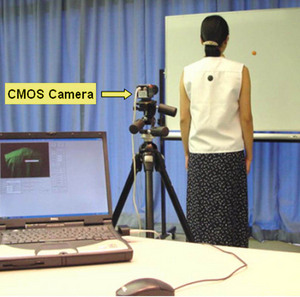Mar. 23, 2007 Research Highlight Biology
Balance in the sway
Nerve control keeps humans upright
 Figure 1: The experimental setup to measure and record body sway. Credit: IEEE Control Syst. Mag./IEEE Control Systems Society/26/20 (2006)
Figure 1: The experimental setup to measure and record body sway. Credit: IEEE Control Syst. Mag./IEEE Control Systems Society/26/20 (2006)
Researchers from RIKEN Frontier Research System in Nagoya have devised a mathematical model of the control system of sensory cells, nerves and muscles that keeps humans upright and balanced, and is essential to standing and walking.
They hope to use their model to develop measurements to aid diagnosis and treatment of balance disorders in elderly people, and to examine the link between deterioration of the balance control system and susceptibility to falls—a serious problem for the aged.
Maintaining balance is an active process which minimizes body movement. The researchers were able to use data on body sway to show that both ageing and closing of the eyes decreases stability.
In a recent paper in IEEE Control Systems Magazine1, the researchers detail the development of their model based on the theory behind standard proportional-integral-derivative (PID) industrial controllers. A controller typically consists of a feedback loop. It takes the value of a measured output from a process, and compares it to a reference setpoint value. It then adjusts the process inputs to minimize the difference or ‘error’ between the output and the setpoint.
Typically such feedback controllers lead to an oscillation around the setpoint, because of the time lag between measurement and action. In PID controllers, that oscillation is damped because the input adjustment is made not only based on the size of the error, but also on its history and rate of change.
In order to examine their model of balance in humans, the researchers gathered experimental data on body sway. They placed a circular black marker, 30 millimeters in diameter, between the shoulder blades of a subject’s back (Fig. 1). Using a digital video camera, the marker’s movement was recorded over 30 or 60 seconds, while the subject was standing still. More than 100 people of a range of ages were recorded with their eyes open and closed.
The researchers found that the elderly displayed greater body sway, suggesting a deteriorating ability to balance. They also showed that balance is vision related, as body sway increases when the eyes are closed compared with open.
The data also allowed the researchers to calculate values for the gain or sensitivity to the rate of change of the error measurement. This value decreases with ageing and when eyes are closed, suggesting it is balance- and stability-related.
“Our research clearly showed nerve control, not weakening muscles or deteriorating sense organs, is the decisive factor in fall vulnerability,” says team leader Hidenori Kimura.
References
- 1. Kimura, H. & Jiang, Y. A PID model of human balance keeping. IEEE Control Systems Magazine 26, 18–23 (2006). doi: 10.1109/AUTEST.2006.283598
